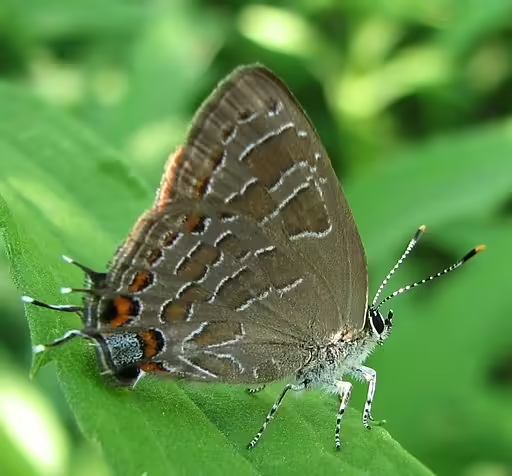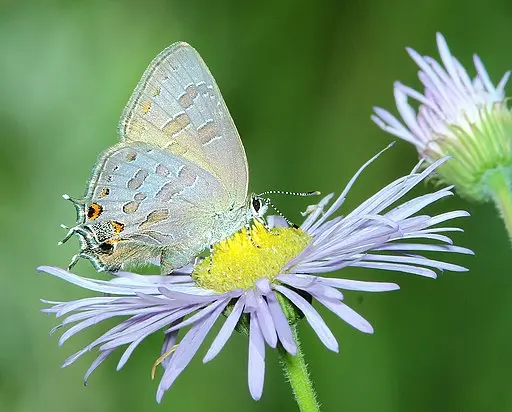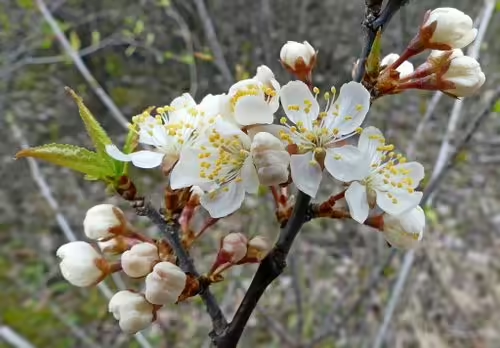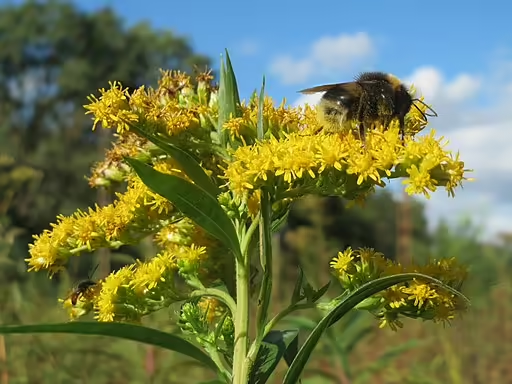Introduction to the Striped Hairstreak
The Striped Hairstreak is a light brown colored butterfly with distinctive white striping that is in the Gossamer Wing Family (Lycaenidae) of butterflies. It flies in the United States and Canada east of the Rocky Mountains. The Striped Hairstreak generally feeds on members of the Rose Family (Rosaceae) and the Heath Family (Ericaceae).
Table of Contents for Striped Hairstreak (Satyrium liparops)
Taxonomy and Naming of the Striped Hairstreak (Satyrium liparops)

Taxonomy
The Striped Hairstreak (Satyrium liparops) was named and described by John Eaton LeConte, an American naturalist, in 1833, based on a collection in Screven County, Georgia (Clench 1972). This species is divided into several subspecies, mainly based on range. The hairstreaks are members of the Gossamer Wing family (Lycaenidae) of butterflies and is in the subfamily Theclinae.
Subspecies of Satyrium liparops
- aliparops (Colorado, Alberta and Manitoba
- fletcheri (Ontario to Alberta in Canada)
- floridensis (Florida)
- liparops (Georgia)
- strigosa (Northeastern United States and Eastern Canada)
Meaning of the Scientific and Common Names
Scientific Name
The genus name, Satyrium, likely comes from the Greek word, Satyr, which was a group of divine entities in nature. These entities are described as half-human and half-animal with goat horns (PlantZAfrica). The species name, liparops, likely comes from the Greek word, liparos, which means shiny or oily. This could be in reference to the wings of this butterfly. However, a clear link was not determined.
Common Name
The common name of this butterfly refers to the white stripes on the tops of the wings. Another common name is “Ogeechee brown hair streak,” used by the discoverer, John Abbot (Clench 1972).
Physical Description

Description
- Color: This butterfly is generally a light brown to almost whitish color with a conspicuous blue area rimmed with orange at the bottom of the wing.
- Wingspan: 1 to 1.5 inches
- Active Flying Time: These butterflies are active from May to August. The activity is earlier in the south and later in the north.
Life Cycle of this Butterfly

Eggs
The greenish eggs are laid singly and overwinter on the branches of host plants.
Larvae
The larva or caterpillars are greenish with a yellow stripe running lengthwise on the body. The caterpillars dine on the host plants in the spring.
Cocoon
The cocoon is a mottled brown color. One source, butterfly identification, states that the chysalis may have a nectar source giving it protection by ants.
Adults
The adults have the characteristic light brown color with white striping on the wing tops. The bottom of the wings has an orange and blue spot. Males will perch on low growing shrubs that are less than 6 feet to look for mates during the day (Scott 1975).
Range of the Striped Hairstreak (Satyrium liparops) in the United States and Canada

This butterfly flies generally throughout the United States, east of the Rocky Mountains and the southern tier of provinces in Canada. In general, a lot of sources list this species as uncommon wherever it occurs.
Habitat

This butterfly is often found in the openings of deciduous forests, forest edges, and in prairie areas near water. It has been noted from successional forests in New York with chokeberry (Shapiro and Shapiro 1973), oak woods in Rhode Island (Pavulaan 1985), and old fields in upstate New York (O’Brien 1983).
Host Plants

The larvae of this moth feed on many plants making it a generalist among butterflies and moths. It often feeds on members of the rose family (Rosaceae), such as cherries (Prunus spp.), hawthorn (Crateagus spp.), and members of the heath family (Ericaceae). Oaks (Quercus spp.) and willows (Salix spp.) have also been listed as host plants (Slansky 1974).
Nectar Plants

The striped hairstreak nectars on a variety of plants, most of which can be found in common pollinator gardens. These include milkweeds (Asclepias spp.), goldenrods (Solidago spp.), dogbane (Aopcynum spp.), viburnums (Viburnum spp.), and clovers (Trifolium spp.).
Frequently Asked Questions
Are the male and females of this butterfly different?
No, the males and females of this species look the same.
What other butterflies look like this butterfly?
This species is distinguished from other hairstreaks by the white stripes present on the tops of the wings (Bouseman and Sternburg 2002).
Where can I get more information on this butterfly?
Interesting facts about this butterfly?
This is the only hairstreak with separated white lines.
References
- Bouseman, John K. and James G. Sternburg. 2002. Field guide to the silkmoths of Illinois. (Champaign, Il: Illinois Natural History Survey).
- Clench, Harry K. 1972. The Boundaru between Satyrium liparops and its subspecies strigosum (Lepidoptera: Lycaenidae). Annals of the Carnegie Museum 44: 11-24.
- O’Brien, Mark F. 1983. New Butterfly Distribution Records For Northern New York State. Journal of the Lepidopterists’ Society 37(1): 92-94.
- Pavulaan, H. 1985. Field Survey of the True Butterflies Papilionoidea of Rhode Island, USA. Journal of the Lepidopterists’ Society 39: 19-25.
- Scott, James A. 1975. Mate-locating behavior of the western North American butterflies. Journal of Research on the Lepidoptera. 14(1): 1-40.
- Shapiro, Arthur M. and Adrienne R. Shapiro. 1973. The ecological associations of the butterflies of Staten Island. Journal of Research on the Lepidoptera 12(2): 65-126.
- Slansky, Frank. 1974. Relationship of Larval-Food Plants and Voltinism Patterns in Temperate Butterflies. Psyche: A Journal of Entomology 81: 243-253.